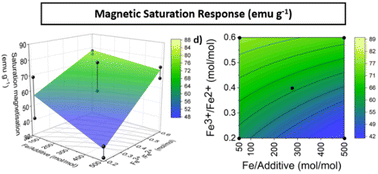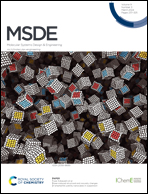Simultaneous optimisation of shape and magnetisation of nanoparticles synthesised using a green bioinspired route†
Abstract
The bioinspired co-precipitation of magnetite nanoparticles (MNP) using additives to tailor particle shape is an attractive alternative to the currently favoured environmentally unsustainable methods of producing shape-controlled particles. In particular, ethylenediamine based additives are able to produce MNP with high-yield under environmentally friendly conditions, yet with the desired control over particle attributes. The effect of tetraethylenepentamine (TEPA) as an additive in the room-temperature co-precipitation (RTCP) of magnetite has been investigated in an iterative Design of Experiments (DoE) strategy, utilising Full Factorial Designs (FFD) and a Path of Steepest Ascent (PSA) optimisation through three consecutive designs. Considering the ferric ratio (Fe3+/Fe2+), Fe/additive ratio, and timepoint of additive addition as factors, the percentage of isotropic faceted particles and saturation magnetisation were measured as responses. After an initial scouting FFD, timepoint of additive addition was found to be insignificant as a factor. A second FFD followed by a PSA optimisation found higher Fe3+/Fe2+ ratios of 0.6, closer to the ideal 2 : 1 stoichiometric ferric ratio produced a higher shape response (an increase in isotropic faceted particles). The interaction between ferric and Fe/additive ratio was found to be significant, as the same level of additive concentration was not as effective at lower ferric ratios. An optimum Fe/additive ratio of 50 : 1 was established, alongside the higher ferric ratio of 0.6 to produce ∼90% isotropic faceted particles with a high magnetism of 77 emu g−1, showing it is possible to synthesise MNP which are both highly magnetic and highly faceted. Since it is a requirement of many industries to use homogeneous particles, the predictive synthesis of these magnetite nanoparticles is a significant step towards the industrial production of green magnetite nanoparticles. These conditions can be utilised for further synthesis or as a basis for further optimisation of shape-tuned magnetite nanoparticle syntheses. This DoE strategy enabled the optimisation of two responses simultaneously to produce high quality MNP.



 Please wait while we load your content...
Please wait while we load your content...